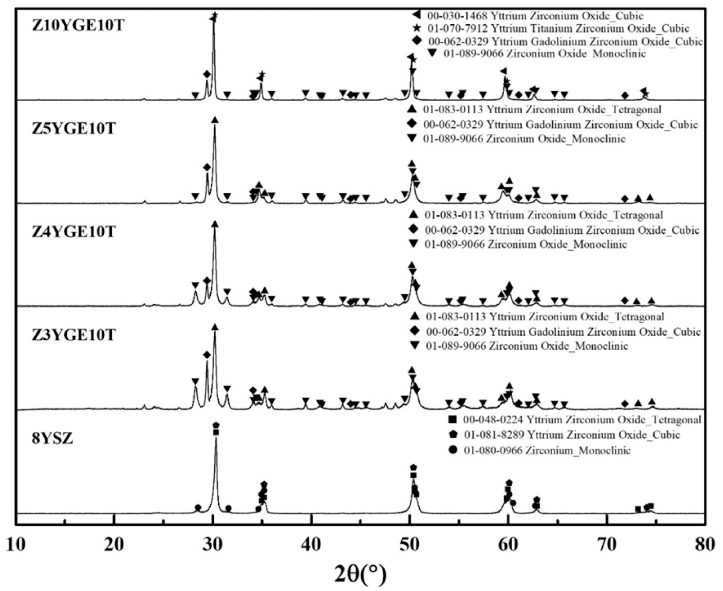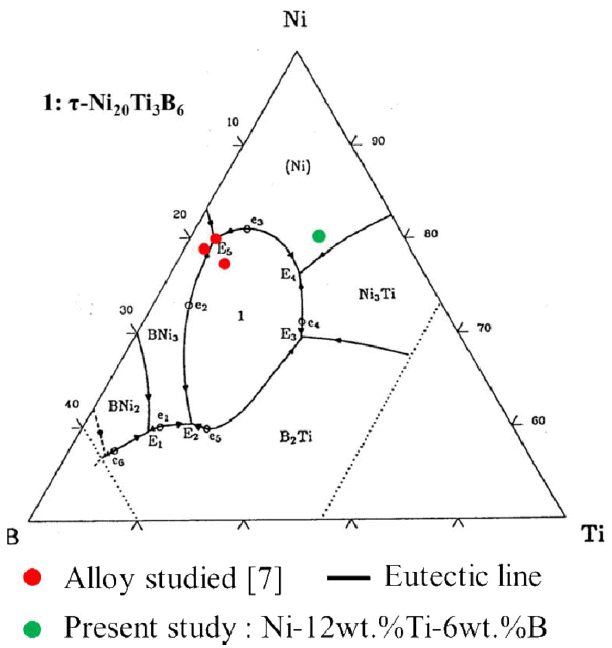Search
- Page Path
- HOME > Search
- [Korean]
- Formation of Phases and Mechanical Properties of YSZ-Based Thermal Barrier Coating Materials Doped with Rare Earth Oxides
- Yong Seok Choi, Gye Won Lee, Sahn Nahm, Yoon suk Oh
- J Powder Mater. 2023;30(5):402-408. Published online October 1, 2023
- DOI: https://doi.org/10.4150/KPMI.2023.30.5.402

- 1,147 View
- 13 Download
-
 Abstract
Abstract
 PDF
PDF This study focused on improving the phase stability and mechanical properties of yttria-stabilized zirconia (YSZ), commonly utilized in gas turbine engine thermal barrier coatings, by incorporating Gd2O3, Er2O3, and TiO2. The addition of 3-valent rare earth elements to YSZ can reduce thermal conductivity and enhance phase stability while adding the 4-valent element TiO2 can improve phase stability and mechanical properties. Sintered specimens were prepared with hot-press equipment. Phase analysis was conducted with X-ray diffraction (XRD), and mechanical properties were assessed with Vickers hardness equipment. The research results revealed that, except for Z10YGE10T, most compositions predominantly exhibited the t-phase. Increasing the content of 3-valent rare earth oxides resulted in a decrease in the monoclinic phase and an increase in the tetragonal phase. In addition, the t(400) angle decreased while the t(004) angle increased. The addition of 10 mol% of 3-valent rare-earth oxides discarded the t-phase and led to the complete development of the c-phase. Adding 10 mol% TiO2 increased hardness than YSZ.
- [English]
- A Study on Synthesis of Ni-Ti-B Alloy by Mechanical Alloying from Elemental Component Powder
- Jung Geun Kim, Yong Ho Park
- J Korean Powder Metall Inst. 2016;23(3):202-206. Published online June 1, 2016
- DOI: https://doi.org/10.4150/KPMI.2016.23.3.202

- 950 View
- 3 Download
- 2 Citations
-
 Abstract
Abstract
 PDF
PDF A Ni-Ti-B alloy powder prepared by mechanical alloying (MA) of individual Ni, Ti, and B components is examined with the aim of elucidating the phase transitions and crystallization during heat treatment. Ti and B atoms penetrating into the Ni lattice result in a Ni (Ti, B) solid solution and an amorphous phase. Differential thermal analysis (DTA) reveals peaks related to the decomposition of the metastable Ni (Ti, B) solid solution and the separation of equilibrium Ni3Ti, TiB2, and τ-Ni20Ti3B6 phases. The exothermal effects in the DTA curves move to lower temperatures with increasing milling time. The formation of a TiB2 phase by annealing indicates that the mechanochemical reaction of the Ni-Ti-B alloy does not comply with the alloy composition in the ternary phase diagram, and Ti-B bonds are found to be more preferable than Ni-B bonds.
-
Citations
Citations to this article as recorded by- Solid‐State Synthesis and Characterization of the Stable Nanostructured Ni21Ti2B6 Phase
Tuncay Simsek, Baris Avar, Sadan Ozcan, Arun K. Chattopadhyay, Bora Kalkan
physica status solidi (b).2021;[Epub] CrossRef - Synthesis and analysis of nanocrystalline β1-Cu3Al and β2-NiAl intermetallic-reinforced aluminum matrix composite by high energy ball milling
Hong-Hai Nguyen, Minh-Thuyet Nguyen, Won Joo Kim, Jin-Chun Kim
Metals and Materials International.2017; 23(1): 202. CrossRef
- Solid‐State Synthesis and Characterization of the Stable Nanostructured Ni21Ti2B6 Phase
- [Korean]
- Evaluation of Material Characteristics with Sintering Temperature in Ti2AlC MAX Phase Material using Spark Plasma Sintering Method
- Chang-Hun Lee, Gyung Rae Baek, Hee Sang Jung, Young-Keun Jeong, Myung Chang Kang
- J Korean Powder Metall Inst. 2015;22(3):175-180. Published online June 1, 2015
- DOI: https://doi.org/10.4150/KPMI.2015.22.3.175

- 782 View
- 7 Download
- 1 Citations
-
 Abstract
Abstract
 PDF
PDF In this study, ternary compound Max Phase Ti2AlC material was mixed by 3D ball milling as a function of ball milling time. More than 99.5 wt% pure Ti2AlC was synthesized by using spark plasma sintering method at 1000, 1100, 1200, and 1300°C for 60 min. The material characteristics of synthesized samples were examined with relative density, hardness, and electrical conductivity as a function of sintering temperature. The phase composition of bulk was identified by X-ray diffraction. On the basis of FE-SEM result, a terraced structures which consists of several laminated layers were observed. And Ti2AlC bulk material obtained a vickers hardness of 5.1 GPa at the sintering temperature of 1100°C.
-
Citations
Citations to this article as recorded by- Synthesis and reaction path of Ti‐Al‐C MAX phases by reaction with Ti‐Al intermetallic compounds and TiC
Hojun Lee, Si Yeon Kim, Young‐In Lee, Jongmin Byun
Journal of the American Ceramic Society.2023; 106(12): 7230. CrossRef
- Synthesis and reaction path of Ti‐Al‐C MAX phases by reaction with Ti‐Al intermetallic compounds and TiC
- [Korean]
- Analysis of the Change in Microstructures of Nano Copper Powders During the Hydrogen Reduction using X-ray Diffraction Patterns and Transmission Electron Microscope, and the Mechanical Property of Compacted Powders
- Dong-Hyun Ahn, Dong Jun Lee, Wooyeol Kim, Lee Ju Park, Hyoung Seop Kim
- J Korean Powder Metall Inst. 2014;21(3):207-214. Published online June 1, 2014
- DOI: https://doi.org/10.4150/KPMI.2014.21.3.207

- 450 View
- 0 Download
-
 Abstract
Abstract
 PDF
PDF In this study, nano-scale copper powders were reduction treated in a hydrogen atmosphere at the relatively high temperature of 350°C in order to eliminate surface oxide layers, which are the main obstacles for fabricating a nano/ultrafine grained bulk parts from the nano-scale powders. The changes in composition and microstructure before and after the hydrogen reduction treatment were evaluated by analyzing X-ray diffraction (XRD) line profile patterns using the convolutional multiple whole profile (CMWP) procedure. In order to confirm the result from the XRD line profile analysis, transmitted electron microscope observations were performed on the specimen of the hydrogen reduction treated powders fabricated using a focused ion beam process. A quasi-statically compacted specimen from the nanoscale powders was produced and Vickers micro-hardness was measured to verify the potential of the powders as the basis for a bulk nano/ultrafine grained material. Although the bonding between particles and the growth in size of the particles occurred, crystallites retained their nano-scale size evaluated using the XRD results. The hardness results demonstrate the usefulness of the powders for a nano/ultrafine grained material, once a good consolidation of powders is achieved.
TOP
 kpmi
kpmi


 First
First Prev
Prev


